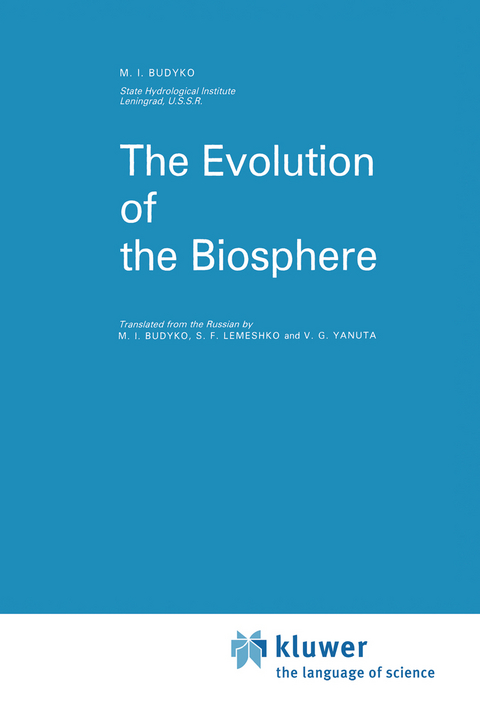
The Evolution of the Biosphere
Springer (Verlag)
978-94-010-8525-0 (ISBN)
THE STUDY OF THE BIOSPHERE The term 'biosphere' first appeared in the works of the French biologist 1.-B. Lamarck and the Austrian geologist E. Suess in the 19th century. In the 20th century, the study of the biosphere attracted considerable attention, largely due to the research of V. I. Vernadsky (1863- 1945). The results Qf Vernadsky's investigations have appeared in a number of publications, including the monograph The Biosphere published in 1926. This work consists of two parts, The Biosphere in Cosmos' and The Zone of Life', written in a form of speculation and reflection that is rarely used in modern studies. This work concerns the distinguishing properties of the space occupied by organisms and the exceptional importance of the activities of these organisms in the formation of their environment. In this and subsequent studies, Vernadsky has laid the foundations of the science of the biosphere, which today plays an important role in th.c many branches of science concerned with the Earth. Several terms have been suggested for the science of the biosphere, including global ecology (a discipline studying the global ecological system, whose meaning is close to that of the biosphere). One of the most prominent predecessors of Vernadsky was his teacher V.
1 The Structure of the Biosphere.- 1.1. The Boundaries of the Biosphere.- 1.2. The Atmosphere.- 1.3. The Hydrosphere.- 1.4. The Lithosphere.- 1.5. Organisms.- 2 Solar Radiation Andits Transformations.- 2.1. Solar Radiation.- 2.2. The Energy Balance.- 2.3. Distribution of the Energy Balance Components.- 3 Climate And Geographical Zones.- 3.1. Contemporary Climate.- 3.2. Polar Ice.- 3.3. The Theory of Climate.- 3.4. The Hydrological Cycle.- 3.5. Geographical Zones.- 4 Plants.- 4.1. Plants in the Biosphere.- 4.2. The Thermal and Water Regimes of Plants.- 4.3. Photosynthesis.- 4.4. The Productivity of Vegetation Cover.- 5 Animals.- 5.1. Animals in the Biosphere.- 5.2. The Heat Regime of Animals and Man.- 5.3. Ecological Systems.- 6 History of the Biosphere.- 6.1. Origin of the Biosphere.- 6.2. Geochronologic Scale and the History of Organisms.- 6.3. Lithosphere and Hydrosphere.- 7 Changes of the Atmosphere.- 7.1. Chemical Composition of the Atmosphere and the Life Activity of Organisms.- 7.2. Chemical Composition of the Atmosphere in Phanerozoic Time.- 7.3. Climates in the Geological Past.- 7.4. Causes of Climatic Change.- 8 The Evoluton of Organisms.- 8.1. Abiotic Factors of Evolution.- 8.2. Critical Epochs in Geological History.- 8.3. Macroevolution.- 9 Man and Biosphere.- 9.1. Formation of the Noosphere.- 9.2. The Origin of Man.- 9.3. The Impact of Ancient Man on the Biosphere.- 9.4. Contemporary Man’s Impact on the Biosphere.- 10 The Future of the Biosphere.- 10.1. Modern Climatic Change.- 10.2. Expected Changes of the Biosphere.- 10.3. Man in the Universe.- 10.4 Preservation of the Biosphere.- Conclusion.- References.
| Reihe/Serie | Atmospheric and Oceanographic Sciences Library ; 9 |
|---|---|
| Zusatzinfo | XVI, 424 p. |
| Verlagsort | Dordrecht |
| Sprache | englisch |
| Maße | 155 x 235 mm |
| Themenwelt | Sachbuch/Ratgeber ► Natur / Technik ► Garten |
| Naturwissenschaften ► Geowissenschaften ► Geologie | |
| Naturwissenschaften ► Geowissenschaften ► Hydrologie / Ozeanografie | |
| Naturwissenschaften ► Geowissenschaften ► Meteorologie / Klimatologie | |
| ISBN-10 | 94-010-8525-0 / 9401085250 |
| ISBN-13 | 978-94-010-8525-0 / 9789401085250 |
| Zustand | Neuware |
| Informationen gemäß Produktsicherheitsverordnung (GPSR) | |
| Haben Sie eine Frage zum Produkt? |
aus dem Bereich


